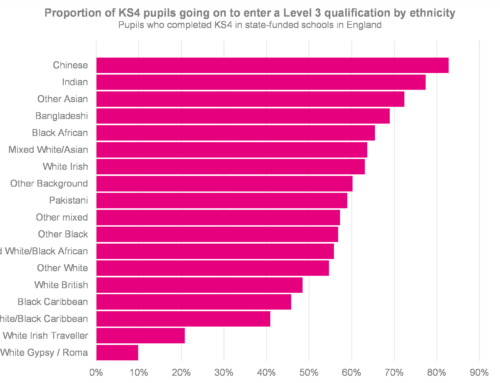Post-16 education is in a period of flux, with major qualification reforms and a drop in per-student spending.
Reformed A-Levels began to be introduced from September 2015, with a concurrent decoupling of AS-Levels.
And, as the IFS have reported [PDF], spending per student in school sixth forms and further education has been falling since 2010/11.
What has been the impact so far on take-up of A-levels?
How many subjects are pupils taking?
We use data on Year 12 (Y12) students’ learning aims collected through the Autumn School Census each year. (Our analysis is restricted to schools, however press coverage suggests that the situation in colleges, which educate over half of 16-18-year-olds, is similar.)
The chart below shows the mean number of learning aims being pursued by Y12 students in school sixth forms, measured in A-Level equivalents[1]. The mean number of A-Levels pursued by pupils fell slightly between 2011/12 and 2015/16, when reformed A-Levels were introduced, and then more sharply (by around a third of an A-Level per pupil) in 2016/17.
Mean number of learning aims, Year 12 students in schools in England 2011/12 to 2016/17
Most of the drop between 2016 and 2017 seems to be due to a fall in the percentage of pupils studying four A-Levels.
As the following chart shows, this fell from 54% in October 2015 to 35% in October 2016.
However, the percentage of Year 12 students pursuing at least three A-Levels fell only modestly, from 75% to 71%.
Number of A-Level learning aims, students in Year 12 in school sixth-forms in England
Have some subjects survived better than others?
Are there certain subjects which have been more affected by this reduction in the number of courses taken?
The chart below shows the percentage change in student numbers by subject between 2011/12 and 2016/17 There were similar numbers of Year 12 students overall in these two years (roughly 207,000), although there were 7,000 (3.6%) fewer Y12 students pursuing at least one A-Level in 2016/17 (185,000 compared to 192,000).
The chart shows all A-Level subjects with at least 10,000 entries in either 2011/12 or 2016/17. Mathematics has the largest number of students, with 65,000 in each year.
Change in Year 12 A-Level student numbers by subject, 2011/12 to 2016/17
(Reformed A-Levels in subjects marked * will only be available for teaching from September 2017. General Studies will not be reformed and will not be available next year).
Although student numbers in most subjects have decreased, further maths, sociology, business studies, economics and government and politics have grown in popularity. Numbers in geography and mathematics were largely unchanged.
Relatively small dips can be observed for chemistry, physics, history and psychology, all of which are pursued by large numbers of Y12 students in school sixth forms (over 30,000). These numbers have held up better than those for English, drama, media studies and PE.
What about other subjects?
This chart only tells part of the story, however.
Although they account for only 10% of A-Level learning aims in 2016/17, there are over 60 other subjects not listed. Some of these, such as French and music, have typically been available in large numbers of school sixth forms, but have tended to be taken by small numbers of students (four to six students on average).
However, between 2011/12 and 2016/17 the number of school sixth forms offering French fell from 1,228 to 1,063, and the number offering music from 953 to 745. (It’s worth saying here that learning aims are recorded against the school at which a student is registered rather than where they are delivered. The number of schools running these subjects may be lower still.)
And there may be more to come. The IFS warns that “spending per student in 16–18 education is set to fall further between 2015–16 and 2019–20”.
This could well lead to a further narrowing of the post-16 curriculum.
Want to stay up-to-date with the latest research from Education Datalab? Sign up to our mailing list to get notifications about new blogposts, or to receive our half-termly newsletter.
[1] For the most part, pupils will be pursuing AS-/A-Levels, although others will be taking popular alternatives such as BTECs. On the assumption that most of those completing AS-Levels will go on to complete full A-Levels we have counted them as a whole (rather than half) A-Level.








Leave A Comment